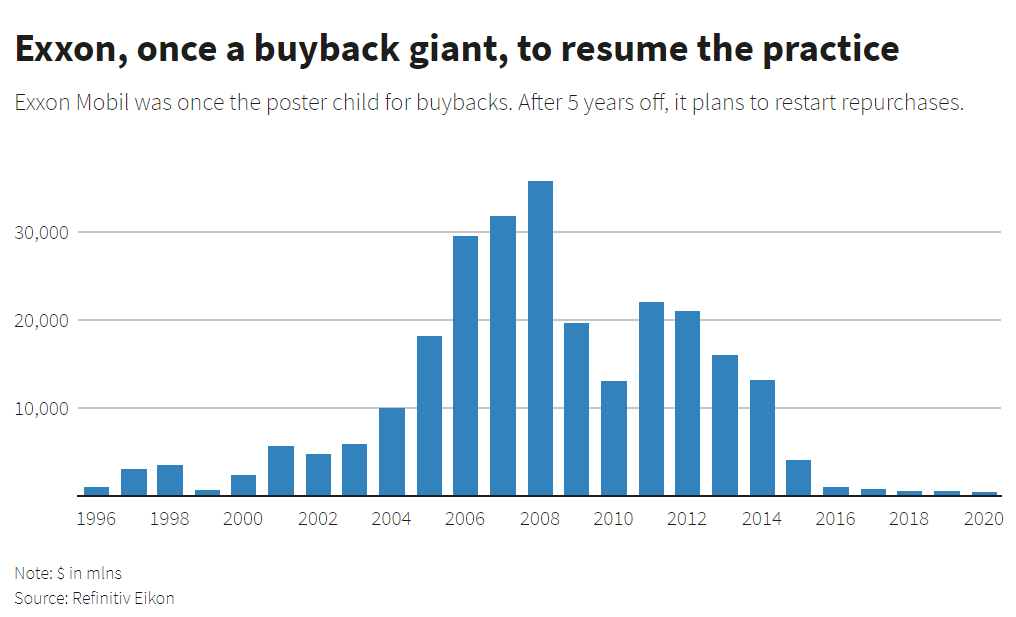Advertisement
Advertisement
Exxon Posts Strongest Results Since 2017, Vows to Resume Share Buybacks
By:
(Reuters) - Exxon Mobil Corp on Friday pledged to revive its long-dormant share repurchase program next year, bolstered by a jump in profit and improved cash flow in the third quarter as rising global economic activity has caused fossil fuel demand to surge.
In this article:
The higher profit follows several years of lackluster returns and heavy spending at Exxon, and as agitated shareholders this year voted to put three new directors on the company’s board due to dissatisfaction with its direction.
For more than a decade, Exxon had been once the largest U.S. corporate repurchaser of shares before suspending the practice in 2016.
“The upside surprise was the buyback program, no one was expecting it this soon,” said equity analyst Paul Sankey at Sankey Research.
The nation’s largest oil and gas company reported net income of $6.75 billion, or $1.57 per share, in the third quarter, the highest since the last quarter of 2017. That compared with a loss of $680 million, or 15 cents per share, in the year-earlier period.
REFINING GAINS
Exxon’s $1.58 a share profit beat the Refinitiv estimate by two cents. Third-quarter results reflected the highest refining profit in at least two years, soaring natural gas prices and energy shortages that pushed oil to a three-year high. Crude prices have continued to climb to near a seven-year high.
Exxon shares finished up 16 cents at $64.49 as some analysts expressed disappointed in the size of buyback program.
The company’s three businesses delivered higher returns from past cost-cutting restructurings and as the global economy emerges from the coronavirus pandemic, Chief Executive Officer Darren Woods said.
The benefits of those changes “are manifesting themselves,” Woods told analysts on a conference call, adding that Exxon expects to “deliver the same growth in earnings and cash flow as our pre-pandemic plans” that called for $30 billion in annual profit by 2025.
That outlook will allow the company to resume buybacks starting next year under a plan to spend up to $10 billion on share repurchases through 2023, Exxon said.
“The macro winds are at Exxon’s back,” said Stewart Glickman, energy equity analyst at CFRA Research.
CARBON EMISSIONS CUTS
In 2016, Exxon cut share repurchases amid weak results, saying it would buy shares only to offset dilution from executive pay plans as opposed to returning cash to shareholders.
In the decade prior, Exxon spent $210 billion on its own stock, more than any other U.S. company in that period.
A day after Exxon’s Woods appeared before Congress to address the company’s previous dismissal of global warming, Exxon said it would increase spending to cut its carbon emissions to $15 billion between 2022 and 2027.
Profits in oil and gas soared in the third quarter on the strength of international demand, reaching nearly $4 billion compared with a $383 million loss a year ago. Chemical profits slipped from last quarter’s high but more than tripled from the same period last year.
The company said it will benefit in the fourth quarter from higher oil and gas volumes, increased European seasonal gas demand and the $1 billion sale of its UK North Sea assets.
Exxon shares are up than 50% this year, as earnings bounced back from last year’s historic loss, but remain below where they traded in early 2020. This year’s profit has allowed the company to repay about $11 billion in debt taken on last year to cover its dividend.
Earlier this year, Exxon spent heavily on a proxy battle waged by a hedge fund unhappy with the oil and gas company’s strategy. The fund, Engine No. 1, was successful in convincing enough shareholders to vote for three new directors to serve on Exxon’s board.

(Reporting by Arathy S Nair in Bengaluru; Editing by Shounak Dasgupta, Steve Orlofsky and Paul Simao)
About the Author
Reuterscontributor
Reuters, the news and media division of Thomson Reuters, is the world’s largest international multimedia news provider reaching more than one billion people every day. Reuters provides trusted business, financial, national, and international news to professionals via Thomson Reuters desktops, the world's media organizations, and directly to consumers at Reuters.com and via Reuters TV. Learn more about Thomson Reuters products:
Latest news and analysis
Advertisement
